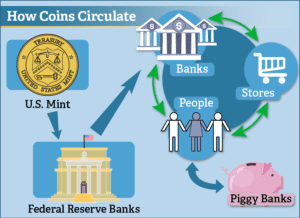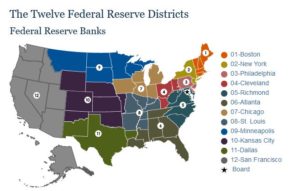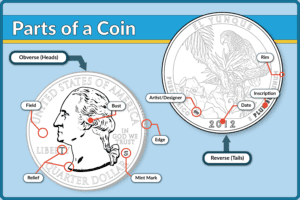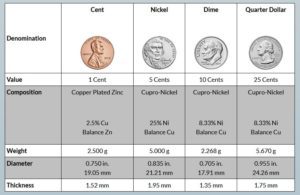A Coins for Kids Post.
All About Coins
What are coins? Coins are small metallic discs made for use as money. Each year the United States Mint makes more than 10 billion coins! That’s a heck of a lotta money.
Every day coin(s) are known as “in circulation”. These are coins that you use at the grocery store, vending machines, etc.
How do coins circulate?
Circulation Flow:

Coin(s) circulate from the U.S. Mint to the Federal Reserve Banks throughout the nation. Currently, there are 12 Federal Reserve Districts in the United States:

Depending on where you live in the United States, determines which Federal Reserve District will send coins to the banks nearest you. Which Federal Reserve Bank serves your area?
Stores and other people often go to the bank to trade cash for coin(s). So they can always make change when needed. Which in turn, people like you and me, when we receive change – we usually spend it to keep it in circulation. Or save it in our piggy banks, so we can buy something we really want later.
What are the parts of a coin?
Coin Parts:

Heads or Tails?
Different sizes and designs make up different types of coins. As well as different metals. But every coin has two sides. Heads, known as the obverse. And tails, known as the reverse. Each side depicts a design or artwork. Often including a person from the neck up. Referred to as a bust. For instance, on the Quarter, there is a bust of President George Washington.
Outside of A Coin
The outer surface of the coin can have lettering, reeding, or designings. This is called the edge. The area near the edge which is raised is known as the rim.
On The Coin
The area in the background of a coin, where it is blank, is known as the field. Throughout the coin, there is markings. For instance “United States of America” and “Liberty”. The depth of the markings and how much they are raised above the field, determines their “relief”. There are three basic reliefs used to describe a coins markings.
-
Low Relief
- Which means the writings/markings are only slightly raised. This version isn’t considered “ideal” when collecting coins . But it is very ideal when making coins to be used in circulation.
-
High Relief
- This means the writings/markings are very raised. This version is considered “ideal” when collecting coins. It creates high detail and makes the coin look beautiful.
-
Incuse
- It is the opposite of a relief. It refers to an area of the coin that has been sunken in. Whether by design or accident.
There are other markings on coins as well.
Mint Mark
A letter or letters that let you know where a coin was minted.
Sculptor/Artist
Initials of the person who designed the coin.
Date
The year on a coin.
Inscription
Legend or lettering on a coin. For instance, “E Pluribus Unum”. Which is Latin for “Out of Many, One”. It is the motto of the United States of America.
What are coins made of?
Coin Composition

The United States Mint makes a lot of coins. But not all coins are worth the same value. In the chart above is the most common circulating coins. The chart details their value, metal makeup, how much they weigh, and their size. However, the U.S. Mint used to make coins out of Silver. Nickels, Dimes, Quarters, Half Dollars, and Dollars, are worth a lot more money than just their face value. Why? Because Silver is worth more than copper or nickel.
You can learn more about Silver Coins here!
Vermillion Enterprises – Serving areas nationwide and throughout Florida.

